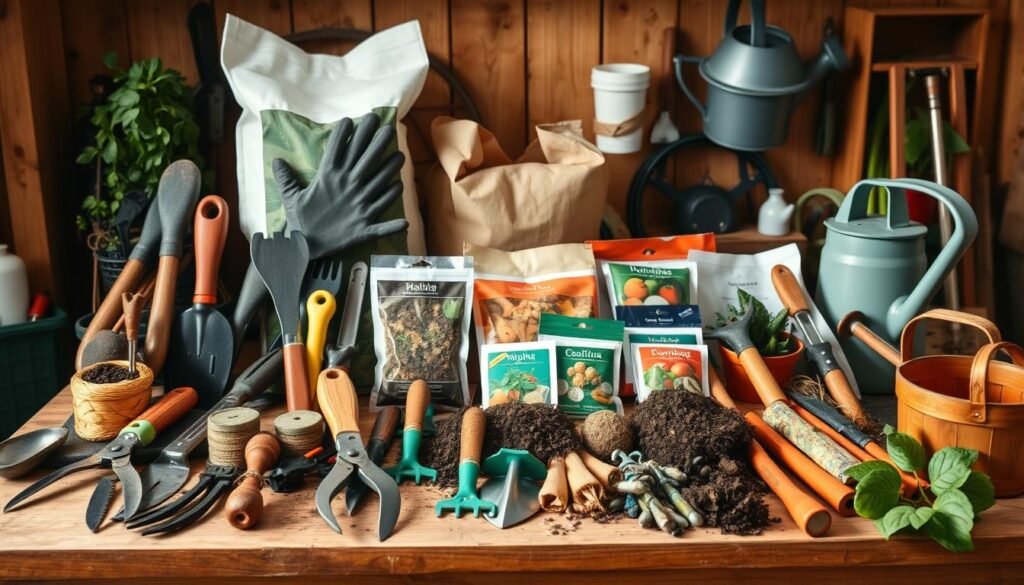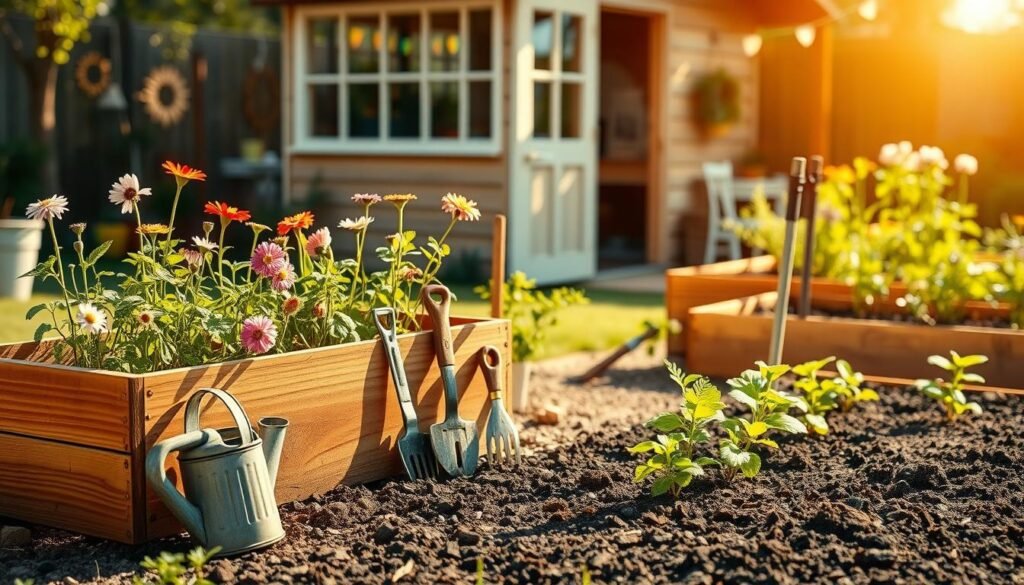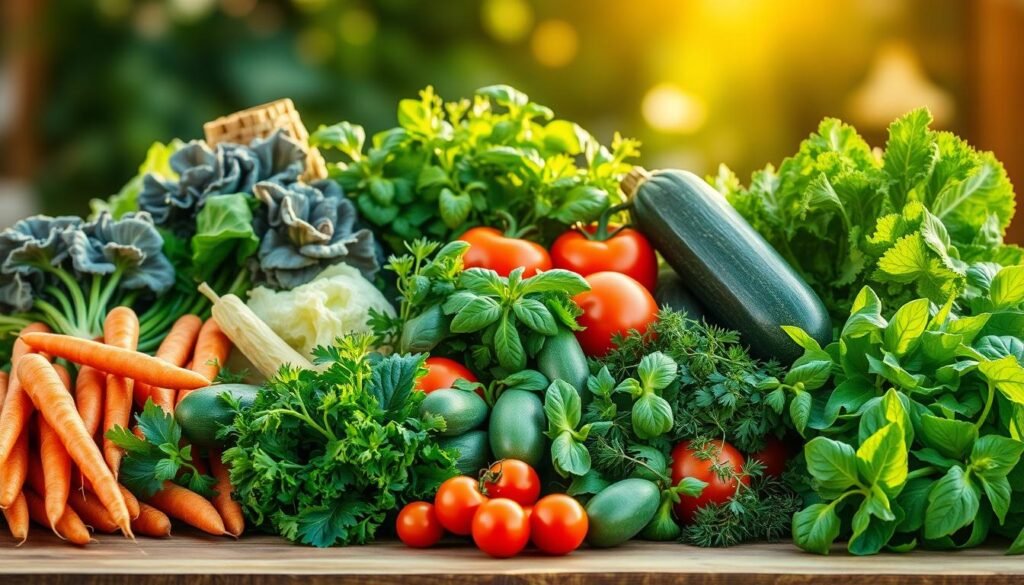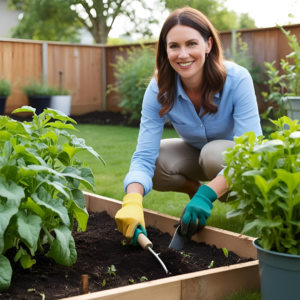Did you know that homegrown vegetables can contain up to 40% more nutrients than store-bought ones? That’s just one reason I decided to dive into gardening. As a beginner, I wanted to grow my own fresh produce and experience the joy of harvesting my own food.
However, choosing the right garden location is crucial. A sunny spot with well-draining soil makes all the difference. I learned that most vegetables need at least 6 hours of sunlight daily. Starting small is also key—beginning with a manageable garden size helps avoid overwhelm and ensures success.
Finally, quality seeds and composted soil are essential for healthy plants. I’m excited to share my journey, from planning my garden to troubleshooting common challenges. This guide is designed to be beginner-friendly, offering practical tips and firsthand experiences to help you grow your green thumb.
Key Takeaways
- Homegrown vegetables are more nutritious than store-bought ones.
- Choose a sunny location with well-draining soil for your garden.
- Start small to avoid frustration and ensure success.
- Use quality seeds and composted soil for healthier plants.
- Most vegetables need at least 6 hours of sunlight daily.
Laying the Foundation: Planning Your Garden
Planning a garden is like creating a blueprint for nature’s masterpiece. It’s the first step toward growing healthy plants and enjoying fresh vegetables. A well-thought-out plan ensures your garden thrives from the start.
Choosing the Perfect Location
Finding the right spot for your garden is crucial. I looked for an area that gets at least six hours of sunlight daily. Most vegetables, like tomatoes and beans, need plenty of sun to grow strong. This was tricky when working on my balcony gardening ideas.
I also checked the soil drainage. Water should soak in easily, not pool on the surface. A slightly elevated spot or raised bed can help with this. Avoid areas that are too windy or shaded, as they can stunt plant growth.
Designing Your Garden Layout
Once I found the perfect location, I focused on the layout. I started small, with two raised beds and a few containers. This made it easier to manage and kept me from feeling overwhelmed.
I planned rows with enough space between plants to prevent overcrowding. Companion planting was another key strategy. For example, pairing basil with tomatoes can deter pests naturally.
Here’s a quick comparison of raised beds vs. inground gardening:
| Feature | Raised Beds | Inground |
|---|---|---|
| Weed Control | Fewer weeds | More weeds |
| Watering | More frequent | Less frequent |
| Soil Health | Easier to manage | Requires more effort |
| Cost | Higher initial cost | Lower cost |
Balancing aesthetics and functionality was important. I added pathways for easy access and used compost to enrich the soil. This setup made weeding and harvesting a breeze.
Next, I’ll gather the essential tools and supplies to bring my garden to life. Planning is just the beginning—exciting times are ahead!
Gathering Essential Tools and Supplies
Having the right tools and supplies can make or break your gardening experience. I quickly realized that investing in quality materials is just as important as choosing the perfect location for my garden. Whether it’s seeds, soil, or tools, each element plays a vital role in ensuring healthy plants and a successful harvest.
Selecting High-Quality Seeds and Soil
When I started, I focused on sourcing high-quality seeds. I looked for options with a high germination rate and chose varieties suited to my climate. Heirloom seeds were my top pick because they offer unique flavors and are often more resilient.
Soil quality was another priority. I learned that nutrient-rich, well-draining soil is essential for plant health. Adding organic compost improved the texture and fertility of my garden bed. A soil test kit helped me adjust the pH level to ensure optimal growing conditions.

Must-Have Gardening Tools
Equipping myself with the right tools made gardening much easier. Here’s a list of essentials I found indispensable:
- Garden Shovel: Perfect for digging and moving soil.
- Hoe: Great for weeding and breaking up soil.
- Rakes: Useful for leveling soil and clearing debris.
- Hand Tools: Ideal for planting seedlings and delicate tasks.
- Gloves: Protect your hands from thorns and dirt.
I also invested in supports like tomato cages and trellises for climbing plants. These tools not only made my work more efficient but also helped my plants thrive.
| Tool | Purpose | Durability |
|---|---|---|
| Garden Shovel | Digging and moving soil | Lifetime with care |
| Hoe | Weeding and soil prep | Long-lasting |
| Rakes | Leveling and clearing | Durable |
| Hand Tools | Planting and pruning | Requires sharpening |
| Gloves | Hand protection | Replace annually |
With these tools and supplies, I felt confident and ready to tackle my gardening journey. Proper preparation truly sets the foundation for a thriving garden. It means I can tackle any container gardening flowers project.
How to Get Started With Gardening
Starting a garden can feel overwhelming, but breaking it into simple steps makes it manageable. I began by setting up a small starter garden, focusing on easy-to-grow vegetables like lettuce, radishes, and tomatoes. Mapping out their placement based on “days to maturity” helped me stay organized and avoid overcrowding.
Setting Up Your Starter Garden
Choosing the right plants is crucial for beginners. I selected vegetables that thrive in my climate and require minimal maintenance. Reading seed packets carefully ensured I planted each seed at the correct depth and spacing. This gave them room to grow and access to essential nutrients.

I also decided between transplanting seedlings and sowing seeds directly. For example, I planted tomatoes deeper to encourage root growth. Using a raised bed improved soil drainage and made weeding easier. Here’s a quick list of my starter garden essentials:
- Lettuce: Quick to mature and perfect for beginners.
- Radishes: Ready to harvest in just 3-4 weeks.
- Tomatoes: Planted deeper for stronger roots.
- Green Beans: Easy to grow and space-efficient.
Understanding Planting Times and Techniques
Timing is everything in gardening. I waited until the danger of frost passed in spring before planting. Cool-season crops like lettuce and peas went in early, while warm-season vegetables like tomatoes and peppers followed once the soil warmed up.
I used the Garden Planner tool to automate spacing and planting schedules. It helped me stagger plantings to avoid simultaneous harvests. For example, I planted lettuce every two weeks for a continuous supply. Proper watering was also key—each plant received about one inch of water per week.
Here’s a comparison of cool-season and warm-season vegetables:
| Type | Examples | Planting Time |
|---|---|---|
| Cool-Season | Lettuce, Peas, Broccoli | Early Spring or Fall |
| Warm-Season | Tomatoes, Peppers, Cucumbers | Late Spring or Summer |
Taking the first step in gardening is easier when you focus on small, achievable goals. With a little planning and patience, your starter garden will thrive and provide fresh, homegrown produce.
Vegetable, Fruit, and Herb Selection for Beginners
Choosing the right vegetables, fruits, and herbs is a game-changer for beginner gardeners. I focused on selecting produce that’s easy to grow, suits my local climate, and matches my family’s tastes. This approach made my first gardening experience enjoyable and rewarding. You can also get more help with my bucket gardening guide.

Easy-to-Grow Vegetables and Fruits
Starting with simple crops helped me build confidence. Lettuce, radishes, and green beans were my top picks. These plants grow quickly and require minimal care, making them perfect for beginners. I also added tomatoes and zucchini, which thrive in sunny spots and produce abundant yields.
Here’s a quick list of beginner-friendly options:
- Lettuce: Ready to harvest in just one month.
- Radishes: Mature in about 3-4 weeks.
- Green Beans: Easy to grow and space-efficient.
- Tomatoes: Plant deeper for stronger roots.
Incorporating Companion Planting
Companion planting was a game-changer for my garden. Pairing marigolds with tomatoes naturally deterred pests, while basil improved the flavor of my tomatoes. This technique maximizes space and enhances plant health without chemicals.
Here are some effective companion planting combinations:
- Tomatoes + Basil: Enhances flavor and repels pests.
- Carrots + Onions: Deters carrot flies.
- Cucumbers + Nasturtiums: Attracts beneficial insects.
I also planned my garden layout carefully, ensuring proper spacing to avoid overcrowding. Raised beds made soil management easier and provided better drainage. By selecting produce based on local availability and family preferences, I ensured a successful harvest throughout the growing season.
Navigating Common Gardening Challenges
Every garden faces its own set of challenges, but with the right strategies, they can be managed effectively. Pests and weeds are two of the most common issues I’ve encountered. Over time, I’ve learned that proactive measures and patience are key to keeping my garden healthy.

Pest and Weed Management
Dealing with pests can feel overwhelming, but identifying them early makes a big difference. Aphids, slugs, and snails are frequent visitors in my garden. I’ve found that organic solutions like neem oil and insecticidal soap work wonders. Physical barriers, such as row covers, also help protect my plants.
Weeds are another persistent problem. Regular weeding and proper spacing in garden beds reduce competition for nutrients and water. Mulching is a great way to suppress weeds while keeping the soil moist. I’ve also learned to understand the life cycle of weeds to time my interventions effectively.
Here are some strategies I use to manage pests and weeds:
- Companion Planting: Pairing marigolds with tomatoes deters pests naturally.
- Organic Sprays: Neem oil and soap solutions are safe and effective.
- Mulching: Suppresses weeds and retains soil moisture.
- Regular Monitoring: Checking plants weekly helps catch issues early.
Adapting my strategies throughout the growing season has been crucial. For example, I adjust watering schedules during heatwaves to prevent stress on my plants. Patience and consistent care have taught me that every challenge is an opportunity to learn and improve.
Gardening is a journey, and setbacks are part of the process. By staying proactive and embracing natural solutions, I’ve been able to keep my garden thriving despite the challenges.
Start Your Gardening Journey Today
Gardening has taught me patience, resilience, and the joy of nurturing life from seed to harvest. Starting small with a manageable garden bed allowed me to focus on quality over quantity, ensuring each plant thrived. Proper planning, from selecting the right location to enriching the soil, laid the foundation for success.
Regular care, like watering and weeding, became a rewarding routine. I learned that even small efforts, like daily weeding, make a big difference. Growing fresh vegetables not only nourished my family but also deepened my connection to nature.
I encourage fellow beginners to embrace the journey. Gardening is a continuous learning process, and each season brings new insights. Share your experiences and tips with others—it’s a wonderful way to build a community of like-minded enthusiasts.
Remember, every garden is unique, and so is your journey. With patience and care, you’ll find joy in every leaf, flower, and harvest. Happy gardening!
FAQ
What’s the best location for my garden?
I always look for a spot with at least 6 hours of sunlight daily. Good drainage and proximity to a water source are also key factors for healthy plant growth.
How do I design a garden layout?
I start by sketching the space and grouping plants by their sunlight and water needs. Raised beds or containers work well for small areas, while rows are great for larger plots.
What tools do I need to begin gardening?
I recommend a trowel, gloves, pruning shears, and a watering can. For soil preparation, a rake and shovel are essential. Quality tools make the process smoother.
When is the best time to plant vegetables?
I follow the planting calendar for my region. Cool-season crops like lettuce go in early spring, while tomatoes and beans thrive after the last frost.
Which vegetables are easiest for beginners?
I suggest starting with lettuce, radishes, and green beans. They grow quickly and require minimal maintenance, making them perfect for first-time gardeners.
How do I manage pests naturally?
I use companion planting, like marigolds with tomatoes, to deter pests. Neem oil and diatomaceous earth are also effective, eco-friendly solutions.
Should I use raised beds or plant directly in the ground?
I prefer raised beds for better soil control and drainage, but planting directly in the ground works well if the soil is healthy and well-prepared.
How often should I water my garden?
I check the soil daily and water when the top inch feels dry. Most plants need about 1 inch of water per week, but this varies by weather and plant type.
What’s the best way to improve soil quality?
I mix in compost to enrich the soil with nutrients. Mulching helps retain moisture and suppress weeds, keeping the soil healthy over time.
Can I grow a garden in a small space?
Absolutely! I’ve had success with container gardening and vertical setups. Herbs, lettuce, and cherry tomatoes are great options for limited areas.

